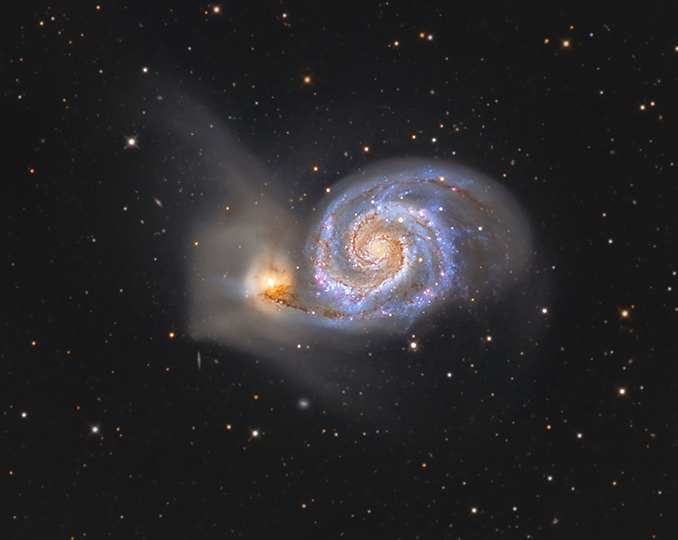



| Observer: | Tom Campbell |
| Location: | Iola, Kansas (Long: 95°24'W Lat: 37°55'N) |
| Equipment: | Discovery DHQ 8" dobsonian |
| Eyepieces: | 1.25" Plössls - 25mm (49x), 15mm (81x), 10mm (122x), 6.5mm (188x), 4mm (305x) |
| Time: | 9:45pm - 10:00pm CST (03:45-04:00 UT) |
| Transparency: | Mostly Clear (7/10) |
| Seeing: | Stable (8/10) |
| Weather: | Temperatures in the lower 60s. There was a slight breeze. |

Tonight, I didn't really have an observing plan. I've observed about all of the Herschel objects that are visible from my backyard, and I didn't feel like travelling out in the country tonight. Just on a whim, I thought I'd take a brief sampling of some well-known objects whose beauty is at least partially a result of their turbulent or violent nature.
| NGC 2392 | Gemini | Planetary Nebula | 9:50pm CDT |
| Eskimo, Clown | RA: 07h 29m 11s | Dec: +20° 55' | Mag: 9.9 |
 |
The bright central star at the center of this planetary nebula is reaching the end of its life. As the hydrogen fuel in the star exhausted itself, it began to expel its outer layers and compressed itself to the point where helium began fusing. As it compressed, it's surface temperature climbed, making it a hot blue star of spectral class O. Eventually, the star will cool down and become a white dwarf, much like the final fate of our own sun. The expelled layers of gas formed the famous eskimo or clown face that is seen today. These gas particles are travelling outward from the star at a rate of about 60km/sec. At 49x, a blue-white central star is easily seen, surrounded by a round patch of nebulosity. Higher powers make the nebulosity more noticeable, but it didn't reveal any additional detail. The brightest part of the nebulosity appeared to be nearest the star. The best view was at 305x. |
||
| Jupiter | Cancer | Planet | 10:00pm CDT |
| RA: 08h 46m 54s | Dec: +18° 48' | Mag: -2.1 | |
 |
The storms raging on Jupiter are the largest in the solar system. The banding is caused by convective currents. The atmospheric gases rise in the light-colored zones and sink back down in the dark belts. The upper atmosphere consists of mainly hydrogen and helium, but also contain trace amounts of methane, ammonia, and water vapor. Between the cloud bands are zones of alternating eastward and westward winds. The planet's rapid rotation (about 10 hours) keep the clouds in continuous motion and confine them to narrow bands. Sometimes, giant hurricane-like storms will form between the cloud bands. These storms can last for centuries. They usually appear as oval-shaped features, and can reach sizes larger than Earth's diameter. The Great Red Spot is one such storm, and was first observed in 1665 by Giovanni Cassini. The best view tonight was at 305x. The details were marvelous. The edges of the two brownish-gray equatorial bands were full of detail and were uneven. Near the meridian, a large white oval was visible on the northern border of the NEB. Some hints of other bands were visible, but they couldn't be seen across the entire face of the planet. Rather, they just appeared as random east-west streaks and gray shading. A large, dark streak was visible at mid-latitudes of the northern hemisphere. |
||
| M 3 | Canes Venatici | Globular Cluster | 10:20pm CDT |
| NGC 5272 | RA: 13h 42m 11s | Dec: +28° 22' | Mag: 6.3 |
 |
Globular clusters exist primarily outside the plane of galaxies, in the region called the galactic halo. They consist mainly of older, low-mass Population II stars, all gravitationally bound to one another. Recent observations of globular clusters have suggested the presence of a supermassive black hole at the heart of many of them, ready to rip away the last remaining fuel of any old geezers who stray too close. Due to its size, the best view for this globular cluster was at 188x. Stars were resolved clear across the core. The cluster didn't appear quite round; rather, it appeared slightly flattened along one edge. |
||
| M 51 (Whirlpool) | Canes Venatici | Interacting Galaxies | 10:30pm CDT |
| NGC 5194/5 | RA: 13h 29m 53s | Dec: +47° 12' | Mag: 9.0 |
 |
When galaxies collide, the effects are awesome and often beautiful. M51, also known as the Whirlpool Galaxy, is one of the first-known examples of interacting galaxies. The smaller companion, NGC 5195, is actually being ripped apart by the gravitational forces of M51, while the larger, spiral structure of M51 has also undergone many structural changes. In recent years, it has been suggested that M51 may have originally been an elliptical galaxy, and the spiral arms were formed from the gravitational forces of the collision. At 125x, the two cores were easily seen tonight, but no real details could be detected. The larger galaxy appeared extremely faint and roundish. With averted vision, I could detect what may have been either a faint foreground star or perhaps an active H-II region about halfway out from the core of M51. |
||
I had planeed to do even more, but thin clouds began to sweep into the area. The stars were getting noticeably dimmer as the evening progressed. I did manage to snap a decent image of Jupiter tonight with my digital camera, though. It can be seen inserted into the StarLog on my webpage.